Scientists have mapped the many ways through which microplastics and other particulate pollutants travel long distances through soils and other porous media. The findings by Princeton University researchers could help us prevent or at least reduce the spread and accumulation of contaminants in food and water sources.

The extent of plastic pollution around the world is nothing short of horrifying. About 1.3 billion tons of plastic will be dumped into our environment by 2040, both on land and in the ocean, according to a global model published this year. Most of this plastic will reach landfills or waters, from where it could reach entire ecosystems and make its way back into humans (yes, we’re all ingesting plastic now).
There’s no clear solution in sight, with microplastics being a large part of the problem.
Until recently, researchers have been largely unaware of how microplastics move around and accumulate in the environment, which makes it more difficult to tackle this form of pollution. Now, a new study showed plastics get stuck when moving through porous materials but later break three, moving substantially further.
Sujit Datta, the lead researcher of the study, described it as a cyclical process. Plastic clogs are formed and then broken up by fluid pressure over time and distance, moving particles further through the pore space until clogs reform. It’s the first time this stop-and-restart process and the condition behind it have identified.
“Not only did we find these cool dynamics of particles getting stuck, clogged, building up deposits and then getting pushed through, but that process enables particles to get spread out over much larger distances than we would have thought otherwise,” said Datta in a statement.
In the study, the researchers tested two types of microplastic particles: sticky and non-sticky. These are the types of microplastics usually found in the environment. The researchers found that there wasn’t a difference between in terms of how they travel. Both particles clog and unclog themselves when exposed to high fluids. Still, there was a difference in how the clusters are formed.
The sticky particles could get trapped at any surface of the solid medium they encountered, while the non-sticky ones got stuck at a narrow passageway. Due to these dynamics, both particles can spread out over large areas and throughout hundreds of pores.
The researchers did experiments on polystyrene microplastic particles in Datta’s lab, assessing with a microscope how the particles move through a transparent porous media the team created. The media mimicked the structure of naturally-occurring environments such as soils, sediments, and groundwater aquifers.
Porous media are usually opaque, which means it’s impossible to see what microplastics are doing or how they flow through the environment. Researchers usually measure what goes in and out of the media, and try to infer the processes going on inside. That’s why the study used a transparent porous media.
“We figured out tricks to make the media transparent. Then, by using fluorescent microparticles, we can watch their dynamics in real-time using a microscope,” said Datta in a statement. “The nice thing is that we can actually see what individual particles are doing under different experimental conditions.”
The researchers hope to use their particle observations to improve parameters for larger-scale models, which would predict the amount and location of contamination. The models would be based on diverse particle sizes and various types of porous media, helping prediction contamination under different conditions.
For Datta, this is only the tip of the iceberg. “Now that we found something so surprising in a system so simple, we’re excited to see what the implications are for more complex systems,” he said. For example, they could try if the principle found in plastic particles also applies in clays, minerals, grains, quartz, viruses, and microbes.
The study was published in the journal Science Advances.






